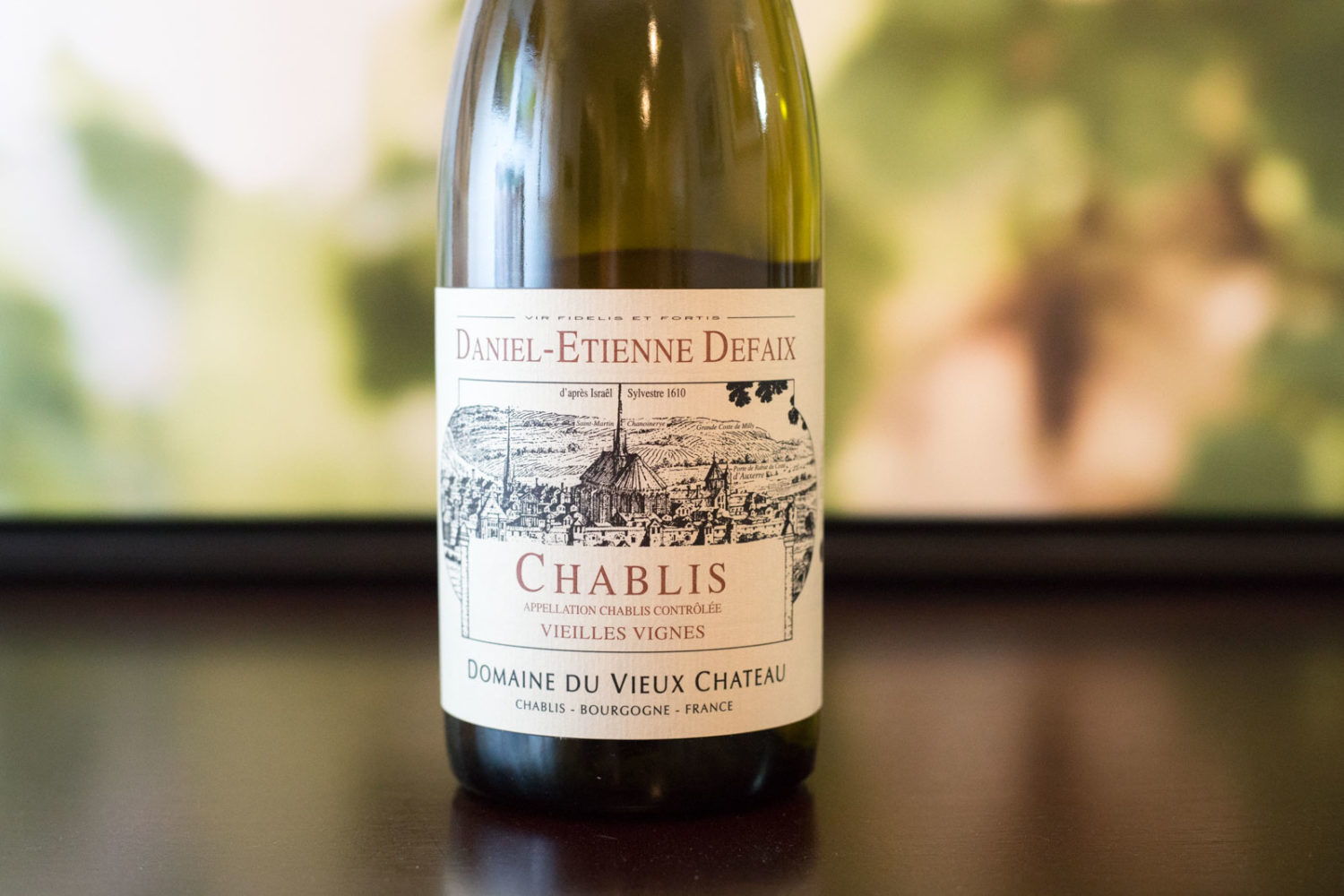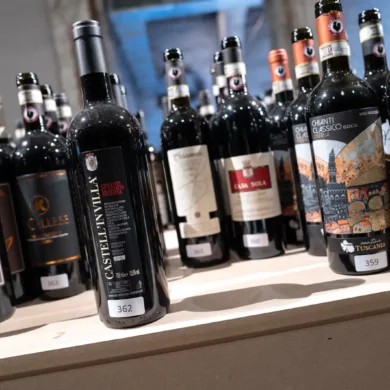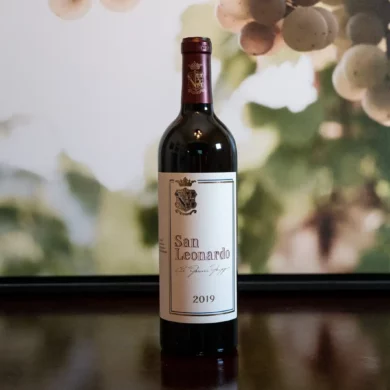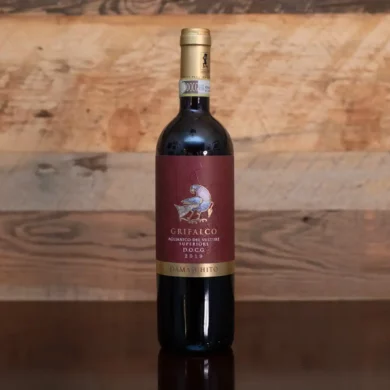Have you ever looked up a tech sheet for a wine on your phone … in the middle of dinner? Or in the middle of a party? Or in the middle of a movie while the dirty dishes wait to be done and the plot lags? I will admit that I have, and I’m not proud of it. But sometimes, the hunt for answers is just too strong: why is this wine the way it is?
A recent Chablis from Domaine Daniel-Etienne Defaix had me doing this the other night. It was a Chablis from old vines: its richly complex aromas and sumptuous, vivacious texture would not leave me alone. It tasted like Chablis, hit all the right buttons like Chablis … yet had a little something extra. What was it?
First, here is how the wine struck me. After that, a give-and-take with the tech sheet for it.
2014 Daniel-Etienne Defaix Chablis Vieilles Vignes
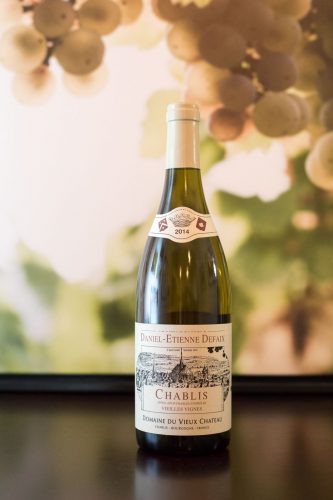 Chablis AOC (Burgundy)
Chablis AOC (Burgundy)
Grapes: Chardonnay (100%)
Alcohol: 12.5%
Ratings: ★★★★★ (out of five)
• Food-friendliness: Impeccable
• Value: As expected
Tasting notes: This wine comes from vines with an age between 45 and 70 years old. Furthermore, it is aged for 30 months before release, an astoundingly long time for a village-level wine. As a result, it rivals even some of the Grand Cru Chablis I’ve sampled.
Aromas are moderately intense, but dense and layered, requiring some focus to pinpoint: reminded me of apricot, pineapple rind, beeswax and roasted almonds. Nearly inexhaustible on the palate, with so much energy. The acidity had a slight tinge of sour lemon to it. A long, refreshing, mineral finish.
Serving suggestion: The definition of a gastronomic wine: bold enough to shine on its own, yet mild enough to bring out hidden details on the plate. Could age for several more years.
Tech Sheet Give-and-Take
Thanks to Rosenthal Wine Merchant, the importer, for providing such a vivid description of the domaine’s winemaking practices:
The vineyards are fertilized, when necessary, with a natural compost of cow and horse manure. Treatments in the vineyards are severely limited and never done within two months of the harvest.
Can I taste this difference? No. But it’s nice to known the vineyards aren’t callously blasted with chemicals throughout the year. The website says their practices are lute raisonnée, which means “the reasoned struggle,” or in other words, not quite organic or biodynamic, and with some cheminal treament, but very limited. A rather unofficial way of putting it. Still, this does taste like a wine made with incredible care.
All the wines at this estate are vinified in a similar fashion. At harvest a strict triage is done to eliminate unripe and unhealthy grapes; the grapes are pressed slowly for three hours, separated parcel by parcel, with only the finest juice maintained for bottling at the domaine.
Again, not surprising. A sign of careful attention to detail. But they are not alone in this practice.
The wines normally ferment for three weeks (sometimes as long as a month) using only indigenous yeasts and at a temperature of 18 degrees Celsius;
OK, now I’m looking up other tech sheets from Chablis. Three weeks? A month? That sounds fairly long for a Chardonnay, for any wine really. Right: it is. Primary fermentation usually takes three to seven days. So what’s going on here? Is this wine’s complexity analogous to a slow-cooked stew? That the extraction of character is somehow more detailed because the primary fermentation is drawn out?
… the malolactic fermentation is always completed but never artificially rushed (on rare occasion, the ML has taken two years to finish).
This I find fascinating. There is a distinct creaminess to this Chablis, more so even than most 1er cru I’ve tasted, so while the use of practice of malolactic fermentation [whereby tart-tasting malic acid is converted to a creamy lactic acid] isn’t surprising, the richness of the wine’s texture feels like a step up. Again: is this because it took longer?
The wines rest on the fine lees in stainless steel cuves for at least 18 months (and sometimes longer for the 1er and Grand Crus) undergoing a type of batonnage without exposure to air and without the addition of sulfur (utilizing the CO2 created by the malolactic fermentation to conserve the freshness of the wines).
For as much talk as there is about terroir and that cliche of “great wine is made in the vineyard,” this is a winemaker’s wine. The fingerprints of the process are now making sense in what I’m tasting. It must be the handling of the lees that are adding these wonderful dimensions to the nose (reminiscent of beeswax and roasted almonds) …
The wines are generally not fined nor are they filtered prior to bottling and the wines are never exposed to a “passage a froid” to precipitate the tartrates … the elevage of two winters in a cold cellar does that work naturally.
The Domaine Daniel-Etienne Defaix releases its wine to the market only after obtaining several years of bottle age at which point the market has the pleasure of having access to wines that more fully express the remarkable and unique terroir that is Chablis.
A few weeks ago, I first tasted this wine in a Chablis line-up, and it stood out massively. Was it the use of oak? No. Was it the terroir? No. It was this long, drawn-out process; the intention with the malolactic fermentation; the extended time on the lees; and finally, this aging process. This is not normal Chablis, but if only it was; maybe then Chablis would rule the world of wine.
An outstanding wine. Find some.
Note also that the high quality corks used at the domaine are purchased two to three years in advance to secure the finest quality and to insure the stability of the cork.
Huh, that’s funny. My cork split open like a gut fish when I pulled it out of the neck. (Nonetheless, it was intact and obviously, it did its job).

